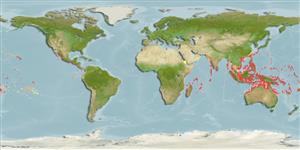Environment: milieu / climate zone / rango de profundidad / distribution range
Ecología
marino asociado a arrecife; rango de profundidad 20 - 40 m (Ref. 1602), usually 20 - ? m (Ref. 1602). Tropical; 30°N - 24°S
Indo-West Pacific.
Tamaño / Peso / Age
Madurez: Lm ? range ? - ? cm
Max length : 16.0 cm TL macho / no sexado; (Ref. 4421)
Espinas dorsales (total) : 1 - 2; Radios blandos dorsales (total) : 30 - 33; Espinas anales: 0; Radios blandos anales: 27 - 30. Blackish brown or bluish black head and anterior portion of body, rest of the body orange. A black blotch surrounding the gill opening. Caudal fin orange; soft dorsal and anal fins yellow; first dorsal spine blackish brown. Pelvic rudiment large not broadly attached to posterior margin of ventral flap. Scale ridge rugosities of male usually develop at about 65 mm SL. Scale spinulation on midbody not closely packed.
Body shape (shape guide): short and / or deep; Cross section: compressed.
Inhabits clear coastal reefs and protected outer reef habitats with rich invertebrate growth (Ref. 48637). Prefers deeper reefs. Often in pairs (Ref. 9710). Sometimes solitary (Ref. 90102). Secretive, adults are usually in pairs (Ref. 48637).
Life cycle and mating behavior
Madurez | Reproducción | Puesta | Huevos | Fecundidad | Larva
Hutchins, J.B., 1986. Review of the monacanthid fish genus Pervagor, with descriptions of two new species. Indo-Pac. Fish. (12):35 p. (Ref. 527)
IUCN Red List Status (Ref. 130435: Version 2025-1)
Threat to humans
Harmless
Human uses
Pesquerías: escaso valor comercial; Acuario: Comercial
Herramientas
Special reports
Download XML
Fuentes de Internet
Estimates based on models
Preferred temperature (Referencia
123201): 24.9 - 29, mean 27.8 °C (based on 316 cells).
Phylogenetic diversity index (Referencia
82804): PD
50 = 0.5039 [Uniqueness, from 0.5 = low to 2.0 = high].
Bayesian length-weight: a=0.01995 (0.00956 - 0.04164), b=2.93 (2.76 - 3.10), in cm total length, based on LWR estimates for this (Sub)family-body shape (Ref.
93245).
Nivel trófico (Referencia
69278): 2.9 ±0.4 se; based on size and trophs of closest relatives
Resiliencia (Referencia
120179): Alto, población duplicada en un tiempo mínimo inferior a 15 meses (Preliminary K or Fecundity.).
Fishing Vulnerability (Ref.
59153): Low vulnerability (10 of 100).
🛈
Nutrients (Ref.
124155): Calcium = 68.7 [29.0, 170.0] mg/100g; Iron = 0.778 [0.357, 1.813] mg/100g; Protein = 17.9 [15.7, 20.1] %; Omega3 = 0.109 [0.051, 0.224] g/100g; Selenium = 30.6 [14.7, 70.2] μg/100g; VitaminA = 66.6 [18.2, 244.0] μg/100g; Zinc = 1.51 [0.98, 2.40] mg/100g (wet weight);
